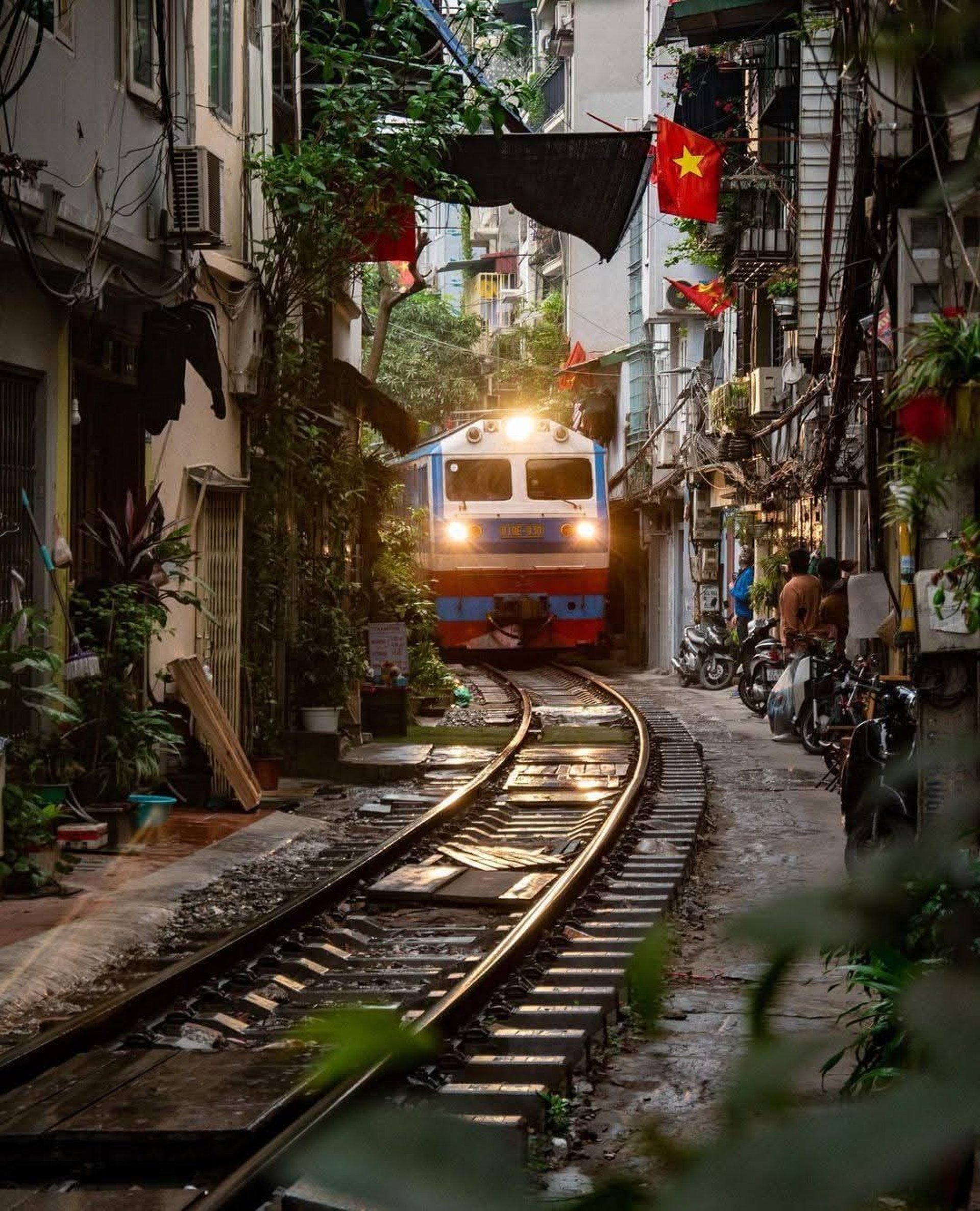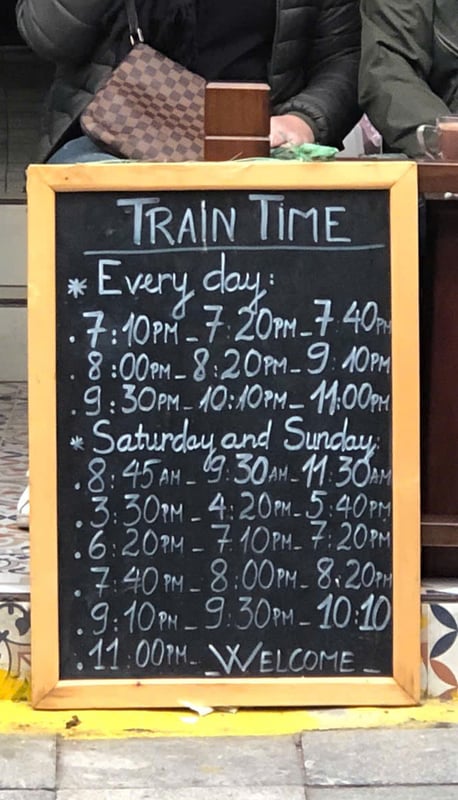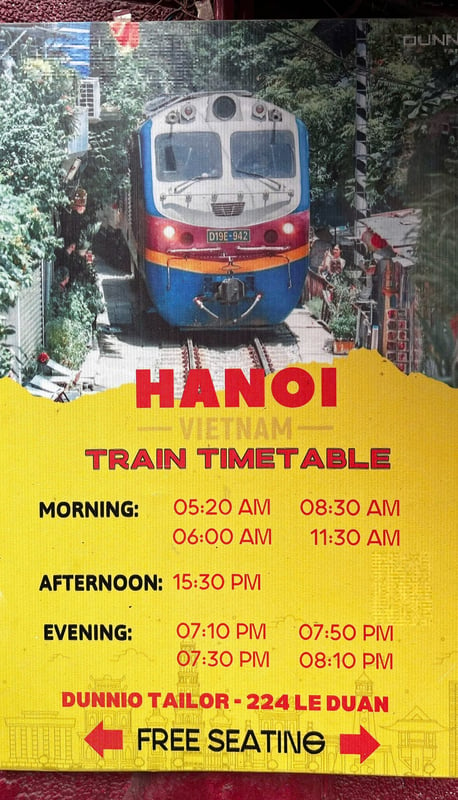Free (tip-based) walking tours every weekend in Hanoi! Get in touch now to secure your slots :)

Guide to Hanoi Train Street: What to Expect in 2025
Hanoi Train Street, a unique and thrilling attraction in Vietnam's capital, has captured the hearts of many travelers worldwide. This narrow alleyway, where trains pass through residential neighborhoods, offers an unforgettable experience. However, due to safety concerns and increasing popularity, visiting Hanoi Train Street has become more complex. In this guide, we'll explore the history, current status, and essential tips for visiting this iconic spot in 2025.
Alex
4/10/20254 min read


The History of Hanoi Train Street
How Hanoi Train Street Came to Be
Built by the French in the early 1900s, the railway snakes through the heart of Hanoi like a steel artery. The most jaw-dropping section runs between Le Duan and Phung Hung streets, where the train brushes past residential buildings just feet away.
Back then, it wasn’t a tourist attraction—it was just part of everyday life. Locals adapted: hanging laundry between the rails, preparing meals in tight corners, and pulling children inside when the train rumbled through. It was life on the edge—literally.
Significance of Phung Hung Train Street and Le Duan Train Street
These two streets define the famous stretch of Train Street. Phung Hung Train street is known for its lively café culture and vibrant murals, while Le Duan Train street is a quieter entrance where you can spot the train with less foot traffic. Both serve as key access points and photo ops, depending on what kind of experience you're after—buzzing or peaceful.
Is Hanoi Train Street Open for Visitors?
Current Status of Hanoi Train Street in 2025
The status of Hanoi Train Street has been fluctuating due to safety concerns and regulatory measures. The short answer: Yes, you can see the train but it’s regulated.
After several closures over the years due to safety concerns, Train Street is now open in 2025—but only under stricter conditions. The government has allowed selected cafés to operate if they meet new safety standards. These cafés act as “safe zones” where tourists can observe the train under supervision.
Walking along the tracks aimlessly? Still a no-no. But booking a seat at a café? That’s your golden ticket.
Regulations and Safety Measures in 2025
Here’s what to keep in mind if you want to see the train:
Access is limited to certain hours before and after train passages.
Visitors must stay within designated cafés or marked viewing zones.
Security officers patrol the area and may ask tourists to leave if seen walking on the tracks.
Drones and tripods are discouraged or outright banned due to the risk of accidents.
Understanding the famous Hanoi Train Street Schedule
How to Get to Hanoi Train Street
There are two popular entrances where the train streets are located:
Phung Hung Street or Tran Phu Street (closest to Long Bien Station): Popular and bustling, with most cafés.
(Walking distance from Phung Hung mural street)
Le Duan Street (near Hanoi Railway Station): Less crowded but fewer café options.
The easiest way to get there? Grab app, a local ride-hailing service, is cheap and convenient. Just type in “Hanoi Train Street” or the name of a café like Railway Café 90 and you’re on your way.
Best Time to Visit Hanoi Train Street
Morning (7:00–9:00 AM): Cooler temperatures, fewer tourists.
Late Afternoon (3:00–5:30 PM): Good lighting for photos and train sightings.
Evening (after 7:00 PM): Great ambiance, but some train schedules shift during the day, so double-check with cafés.
Avoid weekends if you dislike crowds. Train Street is a local favorite and tends to fill up fast.
Where to Check the Train Schedule
Train times change frequently. The best way to stay updated:
Ask the staff at your café—they usually have the latest schedule.
Check Vietnam Railways’ official website (though not all trains passing Train Street are listed).
A rough idea of daily trains includes:
Middle pic: Tentative train schedule at Phung Hung street and Tran Phu street
Bottom pic: Tentative schdule at Le Duan train street.
It’s a narrow alley where homes, coffee cups, selfie sticks, and a massive train all coexist within inches of one another. If that sounds like your kind of thrill, Hanoi Train Street is ready to impress in 2025—although with a few new rules and reminders.
This once-hidden gem has evolved into one of Hanoi’s most iconic (and Instagrammable) attractions. But with rising popularity comes tighter regulations and a bit more planning to truly enjoy it. Don’t worry—we’ve got you covered with this up-to-date guide on how to navigate, enjoy, and stay safe on Hanoi Train Street this year.




What Happens When the Train Approaches
A few moments before the train arrives, café staff will clear the track, ask guests to step aside, and sometimes even whistle to warn people. The scene goes from relaxed sipping to sudden suspense—then silence.
Seconds later, a roaring locomotive slices through, so close you could count the rivets. Cameras flash, hearts race, and you finally understand the buzz around Train Street.
Exploring the Cafés on Hanoi Train Street
Top Cafés on Hanoi Train Street to Try
Looking for the best seats in the house to take photos and videos? Try these:
Railway Café 90 (Phung Hung): One of the original and most popular, with great views and coffee. They also offer cold beverages and traditional Hanoi delicacies.
Cafe Ga Dong Duong: Offers a wide balcony and train-themed decor.
Final Thoughts on Hanoi Train Street
Still wondering if Hanoi Train Street is worth it in 2025?
Absolutely—if you do it right. The thrill of the train, the cozy cafés, the energy of the crowd—it’s a unique collision of culture, chaos, and charm. Just follow the rules, respect the space, and enjoy the moment.
Whether you’re a street photography enthusiast, coffee lover, or someone who thrives on quirky travel experiences, Hanoi Train Street offers a memory you won’t forget.
Quick tips before you go:
Wear comfy shoes (you’ll walk a bit).
Don’t block the tracks, even for photos.
Be patient—it’s a working railway, not a Disneyland attraction.
Bring cash; some cafés don’t accept cards.
Book a local guide if you want a deeper context or nearby cultural spots.
Looking for more Hanoi adventures? Check out Nom Nom Travel’s Hanoi City Tour or join the crowd-favorite Hanoi Weekend Walking Tour to explore the Old Quarter, hidden alleys, and of course, more incredible street eats.
Stay curious, stay safe—and don’t blink when that train comes around the corner!
We sincerely hope this is an informative guide, providing everything you need to know about the origins of Hanoi's famous train street, Hanoi train street locations, and how to plan a visit there based on a written schedule provided.
If you have any questions about Hanoi train street, please feel free to get in touch!
booking.nomnomtravel@gmail.com
info@nomnomtravel.com
+84906168558 (iMess/ Whatsapp available)